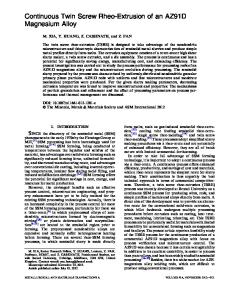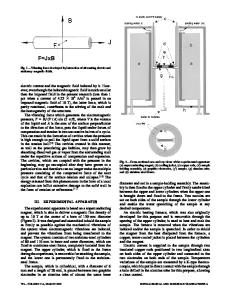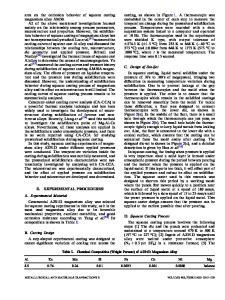Effect of the frequency of electromagnetic vibrations on microstructuralrefinement of AZ91D magnesium alloy
- PDF / 2,313,484 Bytes
- 7 Pages / 612 x 792 pts (letter) Page_size
- 104 Downloads / 345 Views
Jun Kawata Department of Materials Science & Engineering, Nagoya Institute of Technology, Nagoya 466-8555, Japan
Kenji Miwa, Kazuo Yasue, Takuya Tamura, and Yasuji Sakaguchi Institute for Structural and Engineering Materials, National Institute of Advanced Industrial Science and Technology (AIST), Nagoya 463-8560, Japan (Received 26 February 2004; accepted 1 July 2004)
The static magnetic field and the alternating electric field were simultaneously imposed on AZ91D magnesium alloy melt, and ␣-dendrite particles were refined by the electromagnetic vibrations. The effect of the frequency of electromagnetic vibrations on microstructural refinement was quantitatively investigated. In the frequency range from 60 to 1000 Hz, the vibration frequency near 200 Hz was the most effective for the refinement of ␣-dendrite particles, and ␣-dendrite particles were refined up to approximately 100 m from 1800 m at this frequency. However, the effect of refinement by the electromagnetic vibrations became weak at frequencies above 400 Hz. Although the degree of refinement of the primary particles differed with the frequency of the electromagnetic vibrations, the dendrite arm spacing was almost constant, 30–40 m, in our experiment. Therefore, the refinement of primary ␣-dendrite particles is likely to be caused by collapse of dendrite arms due to the cavitation phenomenon and the stirring of the melt.
I. INTRODUCTION
Recently, the reduction the weight of cars has become strongly desired as an energy-saving measure. From this viewpoint, magnesium is a promising candidate because it is the lightest among the practical metals, and it has rich natural resources. However, there are various problems in the commercialization of magnesium alloys, in that magnesium is difficult to handle due to the high activity in the liquid state and it has somewhat poor strength. To prevent the oxidization and combustion of magnesium melt, semi-solid processing methods such as rheocasting1 and the thixomolding method,2–4 have been developed. Use of the semi-solid state means that the operating temperature can be lowered, and the danger of the combustion is reduced due to the decrement of the liquid fraction. In addition, the viscosity of the semi-solid state is sufficiently high compared with that of the liquid state
a)
Research Fellow of the Japan Society for the Promotion of Science. Address all correspondence to this author. e-mail: [email protected] DOI: 10.1557/JMR.2004.0369 J. Mater. Res., Vol. 19, No. 10, Oct 2004
http://journals.cambridge.org
Downloaded: 04 Apr 2015
that the filling to a mold, such as in the die-casting process, is improved and the number of inner defects is remarkably decreased. Thus, semi-solid processing is better suited for the production of magnesium alloy components. The strengthening of magnesium alloys is necessary for the expansion of their fields of application. The mechanical properties of metallic materials are closely related to their microstructures, and thus, refinement of the microstructure leads to i
Data Loading...











